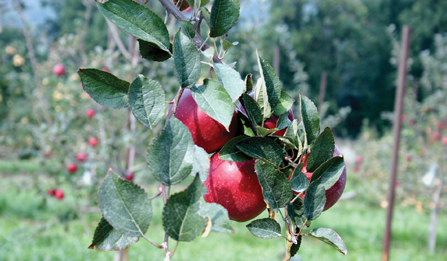
In the changing face of the North
American apple industry, an apple expert from New York state shares
his first-hand knowledge and experiences on how apple producers can
increase profits.
 Apple researcher shares New York state experience
Apple researcher shares New York state experience
In the changing face of the North American apple industry, an apple expert from New York state shares his first-hand knowledge and experiences on how apple producers can increase profits.
Terrence Robinson of Cornell University says in the late 1990s, the New York state apple industry shared a bleak outlook until producers decided to control their future. Prices were “relatively flat” in both the processing and fresh markets and new varieties were on the horizon. Gala, Fuji, Jonagold, Honeycrisp and Cameo are all varieties that were “coming on strong” in the fresh markets, yet producers had very little acreage planted. The apple growers were at a crossroads, he says.
“The industry responded with a very enthusiastic ‘Yes, we should replant, we should retool,’” Robinson recalls. Yet one of the biggest challenges of replanting, he notes, is the down time between the replant and fruit production.
Robinson recommends producers develop a continuous replacement program for their orchards. This allows growers to plan for emerging trends and purge poor performing blocks. He suggests a four to five per cent acreage block for replacement.
If that percentage is exceeded, Robinson points out, it creates too large of a non-producing block and if in the future the producer doesn’t replant, it creates too large of an old stand. Most producers in New York state selected between three and four per cent, he says.
Deciding to replant meant survival for the state’s apple growers, he points out. And now, the plan means ongoing work for producers. “For the New York industry collectively … we had to develop new varieties. Growers that are successful are very vigorous in removing poor performing blocks and have a willingness to adapt to change,” Robinson states.
Producers also need to take into consideration the traditional markets. New varieties are more risky, so Robinson recommends that in addition to planting new varieties, producers maintain some of the traditional varieties, like Cortlands. “Variety is the name of the game,” Robinson says, adding that a new variety should fetch $50 per packed box. That benchmark, he says, is the key. “Any new variety you have to bring to fruition. If you’re not going to go with $40 to $50, I’d say don’t bother.”
Robinson says New York state ranks sixth for U.S. fruit production with the main crops being apples, grapes and strawberries. The apple industry is a $194- million (US) industry with production at 30 million bushels a year, compared to Washington’s annual production of 120 million bushels. The New York crop is split evenly between fresh and processing markets. Production is based mainly along the banks of Lake Ontario and the Hudson River.
Print this page